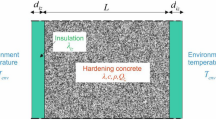Abstract
The surface free energy of asphalt binder is crucial to quantify the adhesion between asphalt and aggregates, especially when an asphalt mixture is exposed to moisture. Most of the current methods use contact angles to determine the surface free energy of asphalt binder. However, the conventional contact angle test methods have limitations in either experimental design or theoretical derivation, which compromise the accuracy of the determined surface free energy. In order to fill this research gap, this paper develops an energy-based framework on the basis of energy balance principles, which can be adopted as an alternative to determine the surface free energy of asphalt binder. In this framework, three energy balance models are derived for the three commonly-used contact angle test methods, including the Wilhelmy Plate method, the Sessile Drop method, and the Tilting Plate method. Based on the developed models, the contact angle between asphalt-liquid can be calculated from the Wilhelmy Plate model or measured directly from the Sessile Drop test and the Tilting Plate test. Using the calculated or measured contact angles, an equation set can be established based on the Young-Dupre equation to solve for the surface free energy of asphalt binder.











Similar content being viewed by others
References
ASTM (2012) Standard practice for effect of water on bituminous-coated aggregate using boiling water. ASTM D3625, West Conshohocken, PA
Guo M, Tan Y, Zhou S (2014) Multiscale test research on interfacial adhesion property of cold mix asphalt. Constr Build Mater 68:769–776
Chen X, Huang B (2008) Evaluation of moisture damage in hot mix asphalt using simple performance and superpave indirect tensile tests. Constr Build Mater 22(9):1950–1962
Zhang D, Luo R (2018) Modifying the BET model of accurately determining specific surface area and surface energy components of aggregates. Constr Build Mater 175:653–663
Xu W, Luo R, Zhang K et al (2018) Experimental investigation on preparation and performance of clear asphalt. Int J Pavement Eng 19(5):416–421
Zhang D, Luo R (2019) Using the surface free energy (SFE) method to investigate the effects of additives on moisture susceptibility of asphalt mixture. Int J Adhes Adhes 95:102437. https://doi.org/10.1016/j.ijadhadh.2019.102437
Oss CJV (2006) Interfacial forces in aqueous media, 2nd edn. CRC Press, New York, USA
Luo R, Zhang D, Zeng Z et al (2015) Effect of surface tension on the measurement of surface energy components of asphalt binders using the wilhelmy plate method. Constr Build Mater 98:900–909
Tan Y, Guo M (2013) Using surface free energy method to study the cohesion and adhesion of asphalt mastic. Constr Build Mater 47:254–260
Extrand CW, Kumagai Y (1995) Liquid drops on an inclined plane: the relation between contact angles, drop shape, and retentive force. J Colloid Interface Sci 170:515–521
Tretinnikov ON, Ikada Y (1994) Dynamic wetting and contact angle hysteresis of polymer surfaces studied with the modified Wilhelmy balance method. Langmuir 10(5):1606–1614
Mennella A, Morrow NR (1995) Point-by-point method of determining contact angles from dynamic Wilhelmy plate data for oil/brine/solid systems. J Colloid Interface Sci 172(1):48–55
Miyama M, Yang Y, Yasuda T et al (1997) Static and dynamic contact angles of water on polymeric surfaces. Langmuir 13(20):5494–5503
Karim AM, Kavehpour HP (2018) Effect of viscous force on dynamic contact angle measurement using Wilhelmy plate method. Colloids Surf A 548:54–60
Zhang D, Liu H (2018) Proposed approach for determining consistent energy parameters based on the surface free energy theory. J Mater Civ Eng 30(11):04018287. https://doi.org/10.1061/(ASCE)MT.1943-5533.0002467
Kwok DY, Neumann AW (1999) Contact angle measurement and contact angle interpretation. Adv Coll Interface Sci 81(3):167–249
Li D (1996) Drop size dependence of contact angles and line tensions of solid-liquid systems. Colloids Surf A 116(1–2):1–23
Vafaei S, Podowski MZ (2005) Analysis of the relationship between liquid droplet size and contact angle. Adv Coll Interface Sci 113(2–3):133–146
Kim HY, Lee HJ, Kang BH (2002) Sliding of liquid drops down an inclined solid surface. J Colloid Interface Sci 247(2):372–380
Roura P (2005) Thermodynamic derivations of the mechanical equilibrium conditions for fluid surfaces: young’s and Lapalce’s equations. Am J Phys 73(12):1139–1147
Allen JS (2003) An analytical solution for determination of small contact angles from sessile drops of arbitrary size. J Colloid Interface Sci 261:481–489
Elsherbini AI (2003) Modeling condensate drops retained on the air-side of heat exchanges. University of Illinois at Urbana-Champaign, Illinois
Elsherbini AI, Jacobi AM (2004) Liquid drops on vertical and inclined surfaces II. A method for approximating drop shapes. J Colloid Interface Sci 273:566–575
Acknowledgements
This paper was financially supported by the National Natural Science Foundation of China (Project No. 52108407) and the Fundamental Research Funds for the Central University (Project NO. 2020kfyXJJS123).
Author information
Authors and Affiliations
Corresponding author
Ethics declarations
Conflict of interest
The authors declare that they have no conflict of interest.
Additional information
Publisher's Note
Springer Nature remains neutral with regard to jurisdictional claims in published maps and institutional affiliations.
Rights and permissions
About this article
Cite this article
Zeng, Z.“., Zhang, D. & Liu, H. Development of an energy-based framework to determine the surface free energy of asphalt binder: theoretical models. Mater Struct 54, 241 (2021). https://doi.org/10.1617/s11527-021-01834-3
Received:
Accepted:
Published:
DOI: https://doi.org/10.1617/s11527-021-01834-3




